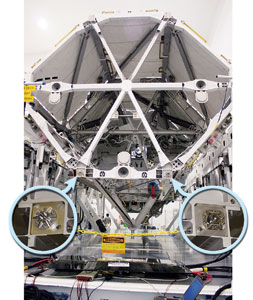...tracked in an Oracle database and photographic library. Most parts—particularly fracture-critical ones—are serialized down to the bracket and fastener level and each part’s provenance recorded in detail.
“All data is available to engineers in the mission evaluation room,” says Smith. “They can track back by serial number to who built it, where materials were produced, milled, etc.”
Physics
Other international coordination issues include making sure documentation is consistent across assemblies and that details like the allocation of power, which needs to change as the station grows, and the management of signal noise, which changes as new elements are in-stalled, are anticipated and controlled. “We watch as it comes together in design and watch for interference issues,” Smith says. “Then you have language and cultural things. But at the bottom, physics is physics.”
 |  |
 | |
 |
One of the most difficult problems is engineering for temperature differential between the lighted side and dark side of an object that can range from -100ºF to +220ºF and more, when one side faces deep space and the other is exposed to full sun. The differential also cycles with every 90-minute orbit’s changing exposure to the sun. “You do some weird things to avoid something hard-mounted,” says Pest.
Using thermal standoffs to allow for expansion to prevent excess load in joints is a coping technique. Another is a liberal use of insulating materials of similar conductivity that will retain those characteristics over service life. Thermal condition can even affect scheduling, with some construction tasks minutely planned for optimal thermal timing.
Engineering and scheduling are built around a standard set of EVA tools, a key one being the Handheld Rotary Device. It is a cordless, drill-like tool for turning mechanisms so astronauts won’t have to make unnecessary motions. Turning is a big thing. “You’re kind of like a bull in a china shop,” Shook says. “The suit material doesn’t stretch very much and you’ve got 4.3 lb per sq in. pressure inside. It becomes fairly rigid.”
Arm motions are restricted and the gloves are like balloons, making movement extremely fatiguing. Astronauts rely on the programmable Swales HRD to turn fastenings. The 13-lb tool has an onboard computer and accepts 14 settings for preset rotations and torque, stopping at whichever comes first. If the torque setting is reached before the specified rotations, the digital display warns that something may be wrong.
Other tools include a variety of retractable tethers—little boxes that can be fastened down to keep items like nuts and sockets from dropping overboard. Electrical and plumbing connection tools that put a premium on leverage and tethered retainability are crucial.
 |
| Click. Motor-driven bolts will spin into nuts to link P3 to station. One nut is fixed (left) and three can shift (right) to ensure a fit. Circular plates and cones are for alignment targeting during approach. (Photos by Tom Sawyer for ENR) |
Another elegant little device NASA uses where motorized bolts won’t work is the “ZipNut,” a custom-made nut whose vertically split threads are spring-loaded and seated in a conical socket inside the barrel. It can be run onto a bolt by simply pushing it down the shaft, then tightened with a quarter turn to hold fast. Because of the conical seat, they tend to grip harder when pulled against and even get tighter, rather than looser, with vibration. ZipNuts seem to be ideal for crossover as a low-cost, mass-produced item, but NASA is one of a few users due to a patent dispute.
Such concerns are overlooked for construction in space, the most precarious and dangerous of jobsites. Ease of use and of assembly are crucial.
“Astronauts are part of design from the beginning,” says Smith. “You think about what they will have to think about, what they will see and what they will have at assembly time.”
